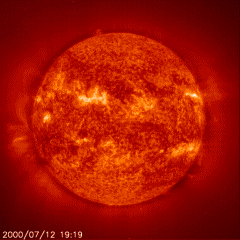The Sun, The Mighty Engine Of Our Solar System
 Our Sun has inspired mythology in almost all cultures, including ancient Egyptians, Aztecs, Native Americans, and Chinese. We now know that the Sun is a huge, bright sphere of mostly ionized gas, about 4.5 billion years old, and is the closest star to Earth at a distance of about 150 million km. The next closest star - Proxima Centauri - is nearly 268,000 times farther away. There are millions of similar stars in the Milky Way Galaxy (and billions of galaxies in the universe). Our Sun supports life on Earth. It powers photosynthesis in green plants and is ultimately the source of all food and fossil fuel. The connection and interaction between the Sun and the Earth drive the seasons, currents in the ocean, weather, and climate.
Our Sun has inspired mythology in almost all cultures, including ancient Egyptians, Aztecs, Native Americans, and Chinese. We now know that the Sun is a huge, bright sphere of mostly ionized gas, about 4.5 billion years old, and is the closest star to Earth at a distance of about 150 million km. The next closest star - Proxima Centauri - is nearly 268,000 times farther away. There are millions of similar stars in the Milky Way Galaxy (and billions of galaxies in the universe). Our Sun supports life on Earth. It powers photosynthesis in green plants and is ultimately the source of all food and fossil fuel. The connection and interaction between the Sun and the Earth drive the seasons, currents in the ocean, weather, and climate.
The Sun is some 333,400 times more massive than Earth and contains 99.86 percent of the mass of the entire solar system. It is held together by gravitational attraction, producing immense pressure and temperature at its core (more than a billion times that of the atmosphere on Earth, with a density about 160 times that of water). A handle-shaped cloud of plasma erupts from the Sun. At the core, the temperature is 16 million degrees kelvin (K), which is sufficient to sustain thermonuclear fusion reactions. The released energy prevents the collapse of the Sun and keeps it in gaseous form. The total energy radiated is 383 billion trillion kilowatts, which is equivalent to the energy generated by 100 billion tons of TNT exploding each second.
In addition to the energy-producing solar core, the interior has two distinct regions: a radiative zone and a convective zone. From the edge of the core outward, first through the radiative zone and then through the convective zone, the temperature decreases from 8 million to 7,000 K. It takes a few hundred thousand years for photons to escape from the dense core and reach the surface.
Fact Credit
NASA Headquarters


